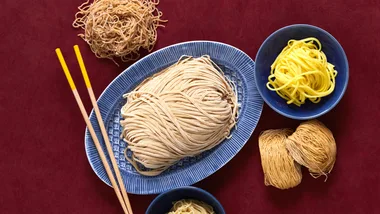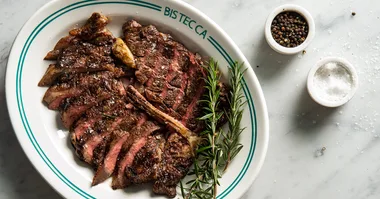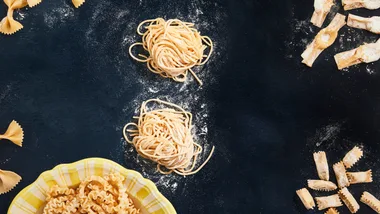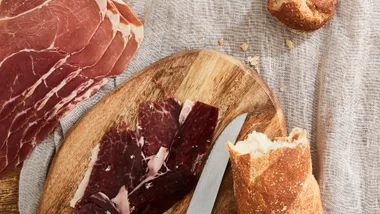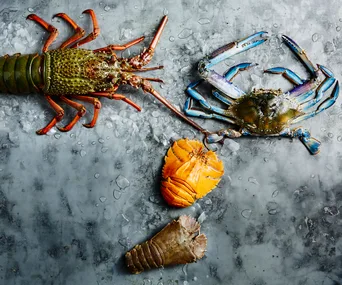The story of caviar is fascinating. Its mystique is entwined with Russian tsars and Iranian shahs, black market smuggling and the wild waters of the Caspian Sea, and the eggs themselves are extracted from a curious-looking dinosaur of a fish. Intrigue, it’s safe to say, has long been an inseparable part of the pleasure of eating caviar.
I remember thinking, “oh, this is just so gourmet” when, as a teenager, I made my parents breakfast with “black caviar” from lumpfish on boiled eggs with mayonnaise from a tube. It was much later, in the kitchens of fine-dining restaurants, that I discovered what all the fuss was about. I remember a party thrown by Moët & Chandon where caviar was served from a tin on ice in a big Champagne bucket. We were handed mother-of-pearl spoons – metal spoons, the story goes, react with caviar and taint the flavour, so mother-of-pearl and horn cutlery are favourites of aficionados, though of course a ceramic spoon would be as effective, if not quite so dashing.
Caviar tastes quite different from salmon or trout eggs and other fish roes. It has wonderful richness and distinct complexity: mineral, salty, fishy, creamy. Caviar varies in flavour, texture, colour and size according to the species of sturgeon that has produced the eggs, and also according to the way it has been processed.
Because it has an intense flavour, caviar is best paired with delicate partners: creamed eggs, potatoes, sour cream – even simply toast or brioche. I especially like the traditional blini or potato rösti with maybe a little dollop of crème fraîche and just a hint of grated horseradish. It needs very little adornment in my opinion – just something to carry the flavours. I’d rather taste the caviar on its own than have it lost in something too complex.
Beluga caviar with scrambled eggs on a croissant with a glass of vintage Krug for breakfast is pretty close to my idea of heaven, but at the same time there are some serious question marks hanging over that pleasure in today’s world. Certainly, there is nothing more decadent and luxurious than caviar. But should we still be eating it?
The vast bulk of the world’s caviar comes from the Caspian Sea, a body of water bounded by Russia, Iran, Turkmenistan, Azerbaijan and Kazakhstan. The sturgeon was once common throughout the waters of the northern hemisphere, but it’s a slow-growing species, and overfishing (for the meat of the fish as much as for its eggs) and pollution have drastically reduced its range and numbers. In its day the Soviet Union kept a very tight control over the valuable fishery and caviar production, keeping quality and numbers at a sustainable level. Following the break-up of the Soviet states, however, the region became a hotbed for illegal trade and in recent decades the stocks of sturgeon have fallen dramatically. In the 1970s up to 27,300 tonnes of sturgeon were caught each year, but in 2010 the catch quota is less than 1000 tonnes, and in recent years fishermen have struggled to come close to filling these drastically reduced quotas.
The sturgeon is thought not to have changed much in the past 200 million years. It’s a curious-looking thing, this living fossil. It’s a large fish, from 2 metres to sometimes 5.5 metres in length, but it takes years to reach reproductive maturity – eight to 10 years for sevruga sturgeon right up to 22 years for the rare and highly prized beluga. Usually the fish are killed before the eggs are extracted, but some caviar farms are removing the eggs surgically so that the fish may go on to produce more. This technique, however, is far from widespread; the flesh of the sturgeon remains a favourite delicacy in the countries surrounding the Caspian.
The process of extracting the eggs, then washing and salting the caviar, is a highly specialised one and requires great skill. The eggs, once salted, are left for a period of time to cure before being packed into tins and sold.
There have been various bans on the importation and sale of wild caviar, but illegal caviar smuggling is rife and very difficult to control. Many authorities say that to successfully replenish stocks there should be a complete global ban on the consumption of wild caviar. Beluga caviar has just returned to the global market after the countries on the Caspian Sea agreed to quotas of the wild-caught fish, but for us the good news is that farmed sturgeon is being produced with great success, particularly in China, the US, Italy France and Germany, and most fine-dining restaurants are using the sustainable farmed eggs. It’s a good news story that, more than most, really does call for Champagne.
 Antonia Pesenti
Antonia Pesenti

